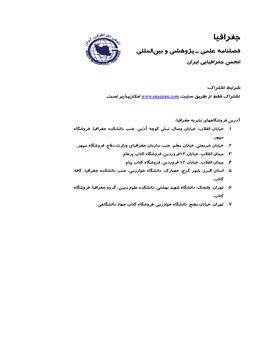Creative City and presenting Iranian Creative City Index
Subject Areas :Vajiheh Zoghiyan 1 , Zahra HashemiDehaghi 2 , bahareh osanlou 3
1 -
2 -
3 -
Keywords: Creative city, Delphi method, Iranian creative city,
Abstract :
The creative city concept has been derived from this field researchers and theorist consideration to the environmental and spatial dimension of creativity. Various indexes have been provided to measuring cities creativity that in all of them, the conditions and features of society has been considered. In this regard, the aim of this study is making a creative city index appropriate for Iranian culture. This study in term of modality is descriptive-analytical, and in term of purpose is a practical research. For data collection, the library, documentary and survey method in form of the Delphi method is used. In next step, with reviewing 15 international creative city index, a list of indicators extracted, then using Delphi method and screening indicators and measures, the Iranian creative city index has been created. The result of Delphi method in three round was the confirmation of 49 measure by Delphi panel members for making Iranian creative city index that from these 49 measure, the 32 measure was drawn from previous studies and 17 measure was provided by Delphi method members.
1. احمدی¬زاده، سیدسعیدرضا؛ کریم¬زاده مطلق، زینب (1393)، ارزیابی قابلیتهای توسعه استان خراسان جنوبی با استفاده از فرایند تحلیل شبکهای (ANP). پژوهشهای محیطزیست، 1، ص 11–22؛
2. رفیعیان، مجتبی؛ شعبانی، مرتضی (2015)، تحلیل شاخصهای خلاقیت شهری در نظام سکونتگاهی استان مازندران. فصلنامه جغرافیا و آمایش شهری- منطقهای، 5(16)، ص 19–34؛
3. عباسی¬اسفنجانی، حسین؛ فروزنده، لطف¬اله (1393)، شناسايي و تبيين عوامل تعیینکننده در تجاریسازی تحقيقات دانشگاهي. نشریه سیاست علم و فناوری، 6(4)، ص 33–46؛
4. Acs, Zoltan J. and Monika I. Megyesi. (2009), “Creativity and Industrial Cities: A Case Study of Baltimore.” Entrepreneurship and Regional Development 21(4):421–39;
5. Correia, Carlos Miguel and Jose da Silva Costa. (2014), “Measuring Creativity in the EU Member States.” Investigaciones Regionales 30:7–26;
6. Factors, K. E. Y., T. O. Consider, During The, Preparation Of, and A. N. Application. (2015), “APPLICANT ’ S HANDBOOK.” UNESCO 1–7;
7. Florida, Richard. (2002), “The Rise of the Creative Class. And How It’s Transforming Work, Leisure and Everyday Life”;
8. Florida, Richard. (2005), Cities and the Creative Class. Routledge.
9. Florida, Richard L. (2011), Creativity and Prosperity: The Global Creativity Index. Martin Prosperity Institute;
10. Florida, Richard and Irene Tinagli. (2004), “Europe in the Creative Age.” Creative Class Group (February):48. Retrieved (http://www.creativeclass.com/rfcgdb/articles/Europe_in_the_Creative_Age_2004.pdf);
11. Habibi, Arash, Azam Sarafrazi, and Sedigheh Izadyar. (2014), “Delphi Technique Theoretical Framework in Qualitative Research.” The International Journal of Engineering and Science 3(4):8–13;
12. Hall, Peter Geoffrey and Stadtplaner Raumplaner. 1998. Cities in Civilization. Pantheon Books New York;
13. Hartley, John, Jason Potts, and Trent MacDonald. (2012), “The CCI Creative City Index 2012.” Cultural Science Journal 5(1):138;
14. Home Affairs Bureau The Hong Kong Special Administrative Region Government. 2005. “A Study on Creativity Index.” Director 1–100;
15. Hsu, Chia-Chien and Brian A. Sandford. (2007), “The Delphi Technique: Making Sense of Consensus.” Practical Assessment, Research & Evaluation 12(10):1–8;
16. Jacobs. Jane. 1969. “The Economy of Cities.” The New York Times, 2003;
17. Keeney, Sinead, Felicity Hasson, and Hugh P. McKenna. (2001), “A Critical Review of the Delphi Technique as a Research Methodology for Nursing.” International Journal of Nursing Studies 38(2):195–200;
18. Kern, Philip and Jan Runge. (2009), “12. KEA Briefing: Towards a European Creativity Index.” Measuring Creativity 191;
19. Kloudova, Jitka and Beata Stehlikova. 2010. “Creativity Index for the Czech Republic in Terms of.” 100–109;
20. Landry, Charles. (2011), “The Creativity City Index.” City, Culture and Society 2(3):173–76;
21. Landry, Charles and Franco Bianchini. (1995), The Creative City. Demos.
22. Rawson, Brendan, John Kreidler, and Philip J. Trounstine. (2005), “Creative Community Index [ Silicon Valley , 2002 and 2005 ]”;
23. Schmidt, Roy C. (1997), “Managing Delphi Surveys Using Nonparametric Statistical Techniques.” Decision Sciences 28(3):763–74;
24. Skulmoski, Gregory J., Francis T. Hartman, and Jennifer Krahn. (2007), “The Delphi Method for Graduate Research.” Journal of Information Technology Education 6:1;
25. van der Spoel, Evie et al. (2015), “Association Analysis of Insulin-like Growth Factor-1 Axis Parameters with Survival and Functional Status in Nonagenarians of the Leiden Longevity Study.” Aging 7(11):956–63.


